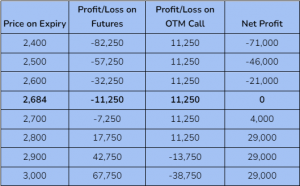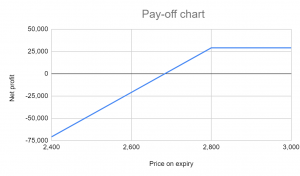A covered call strategy is an options hedging strategy where investors can either hedge an existing long position to create additional income or traders can create fresh positions to generate trading profits.
This strategy involves holding a long position in a stock or futures and selling a call option of the same underlying asset.
Let’s understand how this strategy works.
Derivatives Build-up
After a strong run-up to ₹2,859 in April, the near-month (June) futures contract of Reliance Industries corrected more than 18% to ₹2,380. It has now bounced back to ₹2,729 levels.
The June options data of Reliance Industries shows a significant open interest base of 25.5 lakh contracts at 2,800 call option strike, suggesting that the futures price may face resistance at this point. On the downside, the 2,600 put option strike has a build-up of 11.64 lakh contracts, suggesting that the futures price may find support at this point.
The lot size of Reliance Industries’ F&O contract is 250 shares per lot.
Action
Traders having a neutral to moderately bullish view on the stock can initiate a covered call strategy that combines both stock/futures and options positions.
For instance, if a trader initiates a long position in the futures of Reliance Industries at ₹2,729 (June expiry). Then, he or she can take a counter position by shorting 2,800 call option of the June expiry at a premium of ₹45. Note that the quantity of the futures and options contracts must be equal.
Similarly, an investor holding the stock can cover the long position by shorting 2,800 call option, for an equal quantity.
Let’s understand this strategy with the help of a pay-off table and chart.
Figure 1: Pay-off table

Note: The table illustrated here is for better understanding and educational purposes only
Figure 2: Pay-off chart

Note: The chart illustrated here is for better understanding and educational purposes only
Scenario 1: Price moves above ₹2,729
Now, closer to the expiry, if the price of the futures contract moves higher and closes at ₹2,800, the trader will make a total profit of ₹29,000 (profit on long futures: (71 * 250 = ₹17,750) + profit on short call option: (45 * 250 = ₹11,250).
As you can see in the pay-off table, above ₹2,800, the profit is capped at ₹29,000.
Scenario 2: Price moves below ₹2,729
In this scenario, the trader's loss is covered to the extent of the premium received by shorting the call option, i.e. ₹45. Simply put, if the price goes below ₹2,684, the strategy will make a loss. Therefore, the ₹2,684 is the breakeven point of this strategy which is calculated by subtracting the futures strike price and the call option premium earned (₹2,729 - ₹45= ₹2,684). Below ₹2,684 the losses will increase.
Scenario 3: Price stays at ₹2,729
In such a scenario, the trader will still profit from this strategy by earning the premium on the call option sold. Even though the futures position won’t incur any profit, the trader will capture the entire premium of the call option sold, i.e. 45 * 250 = ₹11,250.
We hope this strategy was simple and easy to understand. We’ll be coming with a lot of strategies which will help you to identify trade setups easily.
Until then, happy trading!
About the author: Kush Bohra is a SEBI-registered investment advisor (INA000008525) and an F&O expert.
Disclaimer
Derivatives trading must be done only by traders who fully understand the risks associated with them and strictly apply risk mechanisms like stop-losses.
We do not recommend any particular stock. The stock name mentioned in this article are purely for showing how to do analysis. Take your own decision before investing.


